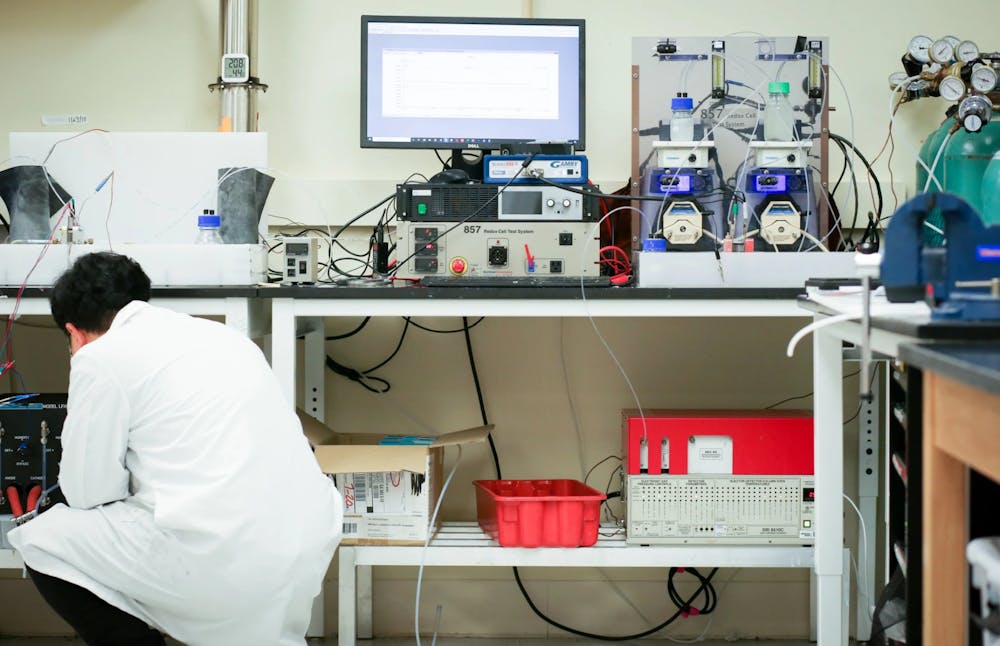The School of Public Health’s Wolman seminar series hosted Marta Hatzell, an associate professor of Mechanical Engineering and Chemical and Biomolecular Engineering at the Georgia Institute of Technology on Tuesday, Sept. 9. Hatzell gave a talk titled “Reactive Carbon Capture and Conversion: Pathways to Carbon-Neutral Fuels and Chemicals,” which highlighted the importance of carbon dioxide capture and its direct conversion into valuable materials. The process of reactive carbon capture and conversion (RCCC) cuts costs and requires less energy than traditional methods, which regenerate carbon dioxide from carbonate streams.
Hatzell first explained the current methods used to manufacture widely-used chemicals such as ethylene and ammonia. She described these as linear processes that involve a catalysis process and a distillation process, both of which emit carbon dioxide. After the fuel or chemical is used, the remaining carbon dioxide exhaust volatilizes into the atmosphere. Furthermore, if the product is a fertilizer, then the nitrogen exhaust runs off into groundwater. These processes inevitably produce many harmful byproducts, which lead to adverse environmental effects.
“Instead of starting with these fossil fuels for chemical production, we can start to think about capturing and recycling waste carbon and nitrogen streams and using these as chemical feedstock. This can help create atomic circularity.” Hatzell said. “1.5 metric tons of carbon is emitted per ton of ethylene, and 1.25 tons of carbon is emitted per ton of ammonia… My lab, the circular electrochemistry lab, looks to examine ways that chemistry that can be performed in a circular way.”
Hatzell points out that a challenging aspect of developing RCCC is the dilution of waste streams. If the stream is too dilute, then the desired separation process can’t be carried out. For example, nitrate is often found in parts per million in the environment, which could potentially be too dilute for separation. As a result, there would be tremendous amounts of mass transport losses, which result in a loss of money and energy. Another critical consideration comes in what forms of carbon and nitrogen are most valuable to recover and what forms can be valorized and used for later.
Aside from these complications, there also remains the issue of how to utilize the carbon that’s been captured. One common suggestion has been to store it underground, but Hatzell refuted the idea, arguing that subterranean carbon would disrupt and add different contaminants into our groundwater.
“There are limited geological reserves for carbon storage, and a lot of the economics suggest capturing and utilizing the carbon dioxide directly may be more economical,” she stated. “What my group is really interested in is the indirect use of carbon dioxide, where we chemically alter the carbon dioxide molecule itself in the goal of creating things like synthetic fuels,” Hatzell said. An example of this direct use would be to store captured carbon dioxide exhaust and mix it with ammonia to obtain urea, which is used to make fertilizer.
“The big overarching question is: how can electrochemistry aid in valorizing carbon dioxide, carbonate or bicarbonate, and how can it be used to make profitable systems?” Hatzell continued.
Hatzell envisions what a large-scale infrastructure system for RCCC might resemble: one that effectively avoids the pitfalls that come with the linear refinery systems that currently dominate. The necessary components involve air capture units that acquire the carbon dioxide, membrane systems that concentrate it and electrolyzers that convert the carbon dioxide into fuels and chemicals. She emphasizes that the challenge comes from creating components that work together efficiently rather than improving a single step.
“As an engineer, what I'm interested in is making sure that the system works together, and figuring out what problems are the biggest problems to work on,” she said. “I have to think about this whole system because if I improve one subsystem by 100% but that subsystem only contributes 1% of the cost, I'm not really moving this technology forward.”
A major challenge comes from the efficiency of the electrolyzers. Even after spending significant amounts of energy on obtaining pure carbon dioxide, up to 75% of the product can be lost within the electrochemical cell. At the cathode of the cell, there are a mixture of products, including ethane, carbon monoxide, methane, hydrogen and carbon dioxide. The products at the anode include carbon dioxide and oxygen, which have proven to be difficult to separate.
As a result, Hatzell and her group have taken an interest in bipolar membrane electrolysis, which involves a two-layer membrane composed of an anion exchange layer and a cation exchange layer. When an electric potential is applied across the whole cell, water is dissociated into hydroxide ions and protons. This reaction helps turn carbonate from the air capture system to carbon dioxide, which can then react at the catalyst layer to produce the desired products. This design also keeps the carbonate from migrating over to the anode, effectively eliminating the need to perform a separation process.
“I think the bipolar membranes give us a lot of benefits, both with carbon capture and with ammonia separations,” Hatzwell states, sharing her enthusiasm for this design. “It's really important to not spend money on extra chemicals, and so these are very useful reactor architectures for both nitrogen and carbon separation.”





